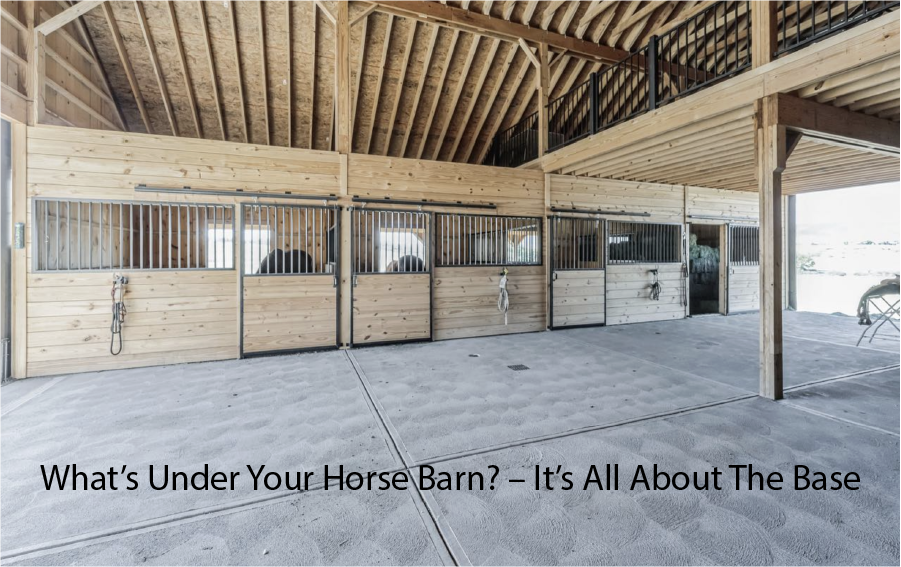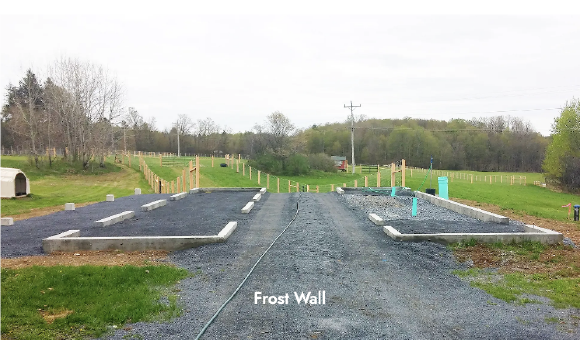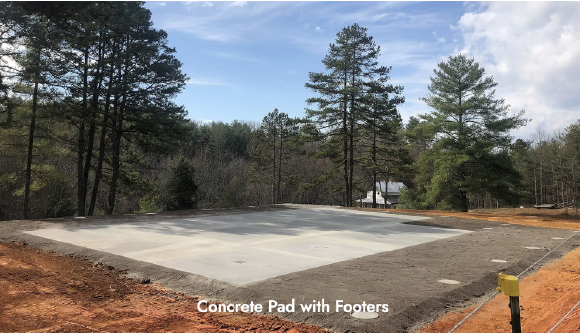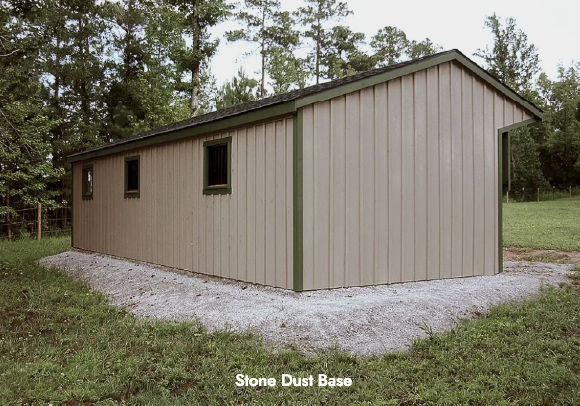What’s Under Your Horse Barn? – It’s All About The Base
by Nikki Alvin-Smith

Somewhat remarkably many folks don’t give much thought to what is under their horse barn before they begin the building process. As long as the grass sod is removed and the area looks relatively level, in go the poles to the holes and the framing task begins.
That’s a shame because a litany of problems are likely to arise quite literally during the daily use of the barn for the foreseeable future. Frost heaving and flooding of stalls and entranceways, alongside stuck stall doors, impossible to clean stabling and snow shed and snow melt madness.
All issues that can be easily avoided with a bit of forethought.
For buildings where a concrete form will be poured to support the structure, often utilized for metal framed buildings, obviously the form walls will be constructed to a level surface. The exception being where the architecture of the building demands stepping of forms. Concrete ‘frost walls’ are often used to mitigate the risk of frost heave.

It IS All About The Base
While renovation of any barn floor is possible after the structure has been built, it is a much sounder practice to get the base right before you begin pouring concrete, digging holes for Sonotubes or pillar supports. It is both less expensive and certainly a great deal less laborious to drill down on the substructure beneath the barn before the horse barn build is completed.
A barn without a proper substructure beneath it will always be a problem to surface floor with concrete, asphalt, rubber or plastic mats or pavers. Whatever your particular preference for stable/stall flooring, aisleways and entranceways, the finished surface will only be and stay as level as the quality of compaction and materials that lay beneath it.
Regardless of whether you opt for the rather old-fashioned approach of having a construction crew build the barn on site or purchase a modular barn that almost ‘instantly’ appears at the property ready to go in a few hours or days, the base beneath the barn and the apron area around it can be prepared well in advance of the start of the project. Especially if you already have the plans for the barn drawn up and available.
Consider not just the materials that constitute the base layers but also what drainage will be required and its location. Stalls without some form of drainage will necessarily be hard to wash down for cleaning. If you are including a wash stall in the barn design then allowance for the drainage is best placed at the back wall of the stall for easy discharge and clean up.
The area that surrounds the perimeter of the barn will be subjected to rain and snow shed from the roof, and while guttering and downspouts can remove water along the roof edge to the corner, that water will also need a drainage method installed to take it away from the barn.
Some of the different types of drainage include French drains, tile drains, footer drains, daylight drains (swales). Certain styles suit certain areas of water discharge but each has its place in the realm of water management.
What Materials Work Best
The best drainage option in most instances is gravel. Often utilized as a component in footer drains with a water permeable fabric overlay to protect the gravel from infusion with soil which will compromise its drainage capacity, gravel comes in different shapes, sizes and types of material.
Crushed or compacted stone products such as limestone, or sand products such as mason sand, compact well and make a super top dressing where the surface layer is required to be hard. Separation of the gravel from the crushed product can be affected with the addition of a layer of construction fabric that is water permeable but again protects from sub structure infusion with drainage blocking agents of dust or stone particles. Though in many cases your ‘dirt crew’ won’t consider this additional step, which is an expensive one, necessary under large surface areas.
Compaction by a roller or by some form of mechanical means is necessary to ensure the gravel and crushed stone layers are not subject to shifting over time. The compaction factor is important and is naturally significantly affected by the depth of each material utilized.
The native soil and the topography of the land all factor into what materials should be used and where drains should be placed. Indeed these factors also affect the choice of where the barn should be optimally sited to avoid flooding and future problems with wind and rain.

Not Exactly On The Level
Most folks believe that a completely level site pad is the required for a building site, and to a certain degree this is true. The area underneath the building should be level.
Impressively a local contractor that prepared the base for our own large building, a 200’ by 70’ indoor arena, managed to attain an overall pitch of the site to within 1” of level. A fact that made the construction company that completed the build extremely happy. Sadly the same contractor negated such accuracy for the barn build. But that’s another story.
Today the equipment utilized for site preparation such as excavators, bulldozers, graders etc. often incorporate a ‘heads-up’ display on the windscreen or dashboard of the machine that showcase when a surface is level with computer-controlled guidance for the operator that handles the correct application of blades and depth calculators. All very high tech and expensive systems that equate to the high hourly rate charged by their owners for the use of such equipment with a trained operator.
Certainly the slight slope or incline necessary for proper drainage (generally ¼” per foot) is an exact science. The need for slopes to interior drains such as those in stalls can be affected at the concrete pouring stage. But the exterior of the barn perimeter should not be level. It is best to slightly slope the ‘pad’ down away from the exterior walls of the barn so that roof run-off and piles of snow that will fall next to the walls of the barn will melt downhill. Away from the interior of the barn.
Costing Questions
The cost variances in a barn building project are often hard to nail down, especially if you have not chosen to take the modular barn building route where the ‘to the penny’ quote and basic building plans are provided. When it comes to site preparation the area and its layout should be known well in advance of the start of the actual build.
Larger modular companies will often help the barn purchaser locate and manage the site preparation, sometimes even allocating a very helpful Project Manager to visit the site and offer a wealth of advice on everything from site placement to design options to meet the client’s individual needs.
Construction companies that offer site preparation services, either directly or through sub-contractors, should have no problem providing a detailed list of specifics of what is included in their quotation for a site preparation. The habit of detailing a ‘time and materials’ estimate is an open-ended arrangement that even if estimated in writing is hard to enforce in court should a discrepancy or argument occur about the final cost or the time frame for completion not be met.
Reputable site preparation contractors will detail the exact materials to be used and the cubic yards of aggregate that will be delivered (including costs for such transport to the site), the anticipated machine time these materials will take to install and exactly what equipment will be used, right down to the machine model numbers.
It is also a good idea to ask the contractor to provide copies of the weight tickets issued at the quarry for each load of materials imported to your site, so that you can verify you have received the product you have paid to have delivered. Compaction rates vary too, but for a horse barn build these are not generally verified by a qualified engineer.
Obviously a larger bulldozer will take less time to complete site preparation tasks for a barn build than a small one, but the larger the machine the more the hourly cost. Meantime a modern piece of equipment may complete the job more quickly than an ancient one just because of the lack of technical help the equipment provides the operator.
The human factor, the operator, is also an essential component in the cost equation. A big piece of equipment in the wrong hands can do major damage. For this reason it is also important that you have the contractor you choose provide you with an insurance certificate, issued directly to you by their own insurance company that names you and your property as covered for any property damage that may occur to the limits of their policy for the duration of the build. Such limits should be sufficient to cover any major occurrence such as damage to existing structures, liability for injury or death to persons on the property etc. Consult your own insurance agent for advice on what should be provided to you by the contractor if you have questions. There is no expense to the contractor to provide this certificate, and naturally ensure the contractor is both licensed and insured at the outset.
The unknown factor for the site preparation crew can be what lies beneath the surface of the land that they cannot see before they start any major cut and fill operation to level the ground. Large rocks, established tree roots, underground springs, buried garbage or other materials such as manure even old buildings, can all play havoc with the time needed to complete the levelling task. For this reason there is often a clause in the contractor’s contract with language to cover what the protocol will be if one or more of these unfortunate incidents occur, which is fair enough. Consider the discovery of a large underground water source may even require moving the site/location for the barn altogether.
There is equipment that can read what is beneath the surface of the ground sonic radar either from the air above via drone etc. or airplane/helicopter, or by handheld operation of similar equipment. The use of this is usually prohibitively expensive to consider for a regular horse barn build.
Factor in weather delays (wet weather makes a site a muddy mess of a building site when large equipment track over it, so site preparation is best left until drier weather arrives; frozen soil can be hard to excavate), diesel or fuel cost market mayhem, and the unknown influences on the bottom line can be hard to predict.
A worthy contractor with an evidenced goodwill and integrity in their operation should be located through careful research before making a written commitment or parting with any money. It is essential that a fairly written contract (it should include an opt-out clause for you and what remediation would be necessary especially if timeline or price cannot be met), is executed by all involved parties. This contract should include both the amounts and timelines for when and what deposits are to be paid.
Don’t be pressured into using a site contractor that you do not feel comfortable with, follow your gut feeling. Do be certain to plan well in advance with contracts in place, as often the window for quarries being open and weather being fair enough to complete construction is short (especially in the North-East USA) and good companies often book up often a year in advance. While smaller jobs can be completed between larger ones, the bigger your particular project the more important it is to get it on the contractor’s books well in advance.



